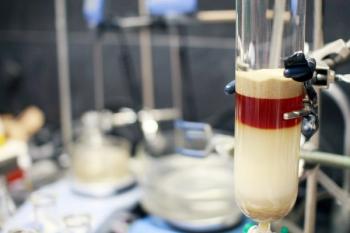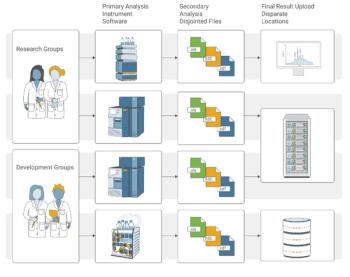
- The Column-04-16-2018
- Volume 14
- Issue 4
Characterizing the Average Composition and Molar Mass Distributions of a Copolymer by SEC–MALS–dRI–UV
The chemical composition of a copolymer material has a substantial impact on its properties and performance. Defining a composition profile is therefore an essential aspect of product development for these materials. The copolymer’s composition often varies considerably with molecular weight (MW), and in the R&D process, therefore, it requires a detailed analysis which maps out composition across the entire MW distribution.
Wei Gao1 and Michelle Chen2, 1The Dow Chemical Company, Michigan, USA, 2Wyatt Technology Corporation, California, USA
The chemical composition of a copolymer material has a substantial impact on its properties and performance. Defining a composition profile is therefore an essential aspect of product development for these materials. The copolymer’s composition often varies considerably with molecular weight (MW), and in the R&D process, therefore, it requires a detailed analysis which maps out composition across the entire MW distribution.
Traditional polymer characterization techniques present some disadvantages when analyzing copolymers. For example, size-exclusion chromatography coupled with differential refractive index detection (SEC–dRI) can be insufficient to perform a comprehensive analysis, while nuclear magnetic resonance (NMR) performed on fractions separated by SEC can involve significant labour, complexity, and cost.
Fortunately, both the absolute molecular weight and composition of randomâcopolymer samples may be determined quickly and accurately, without a fraction collection step or NMR analysis, if at least one of the component species contains a UV-absorbing component. The analysis technique utilizes SEC combined with three sequential on-line detectors: multi-angle light scattering (MALS), differential refractive index (dRI), and UV–vis absorbance (UV).
This article demonstrates how poly(styrene-co-acrylic acid) (PSAA) samples were analyzed to determine co-distributions of molecular weight and composition using a tripleâdetector SEC–MALS–UV–dRI system. Results are compared to reference values obtained by 1H NMR spectroscopy, which is a more labourâintensive method than SEC–MALS–UV–RI.
From controlled-release agents in novel pharmaceuticals to materials for advanced carbon-capture technology, newly-developed industrial copolymers incorporate advanced functionality and performance. The need for greater insight and understanding into polymer composition has stimulated significant advances in routine polymer characterization technology.
Gel permeation chromatography (GPC) with dRI detection is the most common approach to determining the MW and MW distribution of typical polymers. However, GPC–dRI cannot distinguish chemical composition and usually cannot be calibrated correctly for copolymers because appropriate column calibration standards are not available.
SEC–MALS and dRI detection is widely considered a suitable technique to deliver accurate and robust measurements of polymer molecular weight (MW) distributions. Where conventional single detector SEC only delivers a comparative MW result based on reference material, SEC–MALS generates an absolute measurement of MW at each elution volume in the chromatogram, from first principles. SEC–MALS has no need for column calibration based on reference standards that potentially do not represent the sample of interest adequately and produce incorrect molar mass results. SEC–MALS is appropriate for a large variety of analytes including branched polymers and other macromolecules that are not well represented by column calibration standards. However, MALS with dRI alone is not sufficient to provide comprehensive compositional analysis of copolymers.
A common characterization technique for copolymer analysis is proton nuclear magnetic resonance (1H NMR) which excels at determining chemical identity. Standard NMR is only able to provide measurements of the sample-average composition. 1H NMR can be used with preparative fractionation to obtain a coarse size–composition distribution, but this may be impractical to perform regularly. On-line GPC–NMR, GPC–FTIR and 2D-LC instruments have been developed to provide the average chemical composition at elution moment and molecular weight; however, these instruments are usually associated with high capital and operational cost. Techniques like SEC–MALS, which combine the continuous measurement aspect of SEC with an accurate chemical and molecular weight analysis, are appropriate for copolymer development.
Depending on the polymerization mechanism and process, the chemical composition of a copolymer material can vary greatly across the molecular weight distribution of the polymer. When composition varies with size, the copolymer’s specific refractive index increment dn/dc-used in both concentration and light scattering analyses-will change with elution volume during a SEC separation. Therefore, accurate molar mass data cannot be obtained for specific size fractions with SEC–MALS alone.
The addition of a third detection unit offers a solution to this issue. As many monomers include chromophore UVâabsorbing species, UV detectors are widely used to enhance the analytical productivity of SEC–MALS for compositional studies. Modern UV, MALS, and dRI detection units are compatible with a range of separation techniques including GPC, HPLC, and field-flow fractionation. Comprehensive copolymer characterization can be attained using a variety of separation platforms.
To demonstrate the utility of a three-detector SEC system for measuring both composition and molar mass distribution, three poly(styrene-co-acrylic acid) (PSAA) standards underwent compositional analysis with a SEC–MALS–dRI–UV system. The results were then validated against those provided by the manufacturer using NMR spectroscopy.
System Validation
The ability of the MALS–dRI–UV system to determine accurate concentration and molar mass values was validated with a 30 kDa polystyrene (PS) reference standard. Figure 1 shows the MW distribution for the sample.
The UV extinction coefficient of polystyrene was determined by comparing the UV absorbance integrated across the peak with the integrated dRI signal. The analysis assumes complete mass recovery between the two detectors.
Results and Discussion
Figure 2 shows the reaction scheme for PSAA, including the reactive monomers ethenylebenzene (styrene) and t-butyl acrylate and intermediary product poly(styrene–butylacrylate). The final product poly(styrene-co-acrylic acid) was obtained by hydrolysis of the intermediary product. The UV-absorbing component of the final PSAA product is polystyrene (PS) (other components do not absorb at the UV wavelength used here, 254 nm). The molecular weight and polydispersity index (PDI) were calculated from the intermediary product poly(styrene-co-t-butyl acrylate).
MW and PS% Versus Elution Time
Light scattering analysis requires knowledge of the molecule’s dn/dc value and concentration. A single concentration detector such as a differential refractometer cannot determine the concentration of a copolymer when the molecular response (in this case the dn/dc value) is not constant for the sample. Since the composition varies across the chromatogram, concentration and dn/dc must be determined at each elution volume; this is accomplished by combining the dRI and UV signals at each elution point for the following equations:
(1)
where Δn is the measured refractive index difference because the copolymer, (dn/dc)n is the differential refractive increment of component (n = 1,2) of the copolymer, x is the fraction of component 1 in the copolymer, c is the total copolymer weight concentration, Δα is the measured UV absorption, αn is the extinction coefficient of component (n = 1,2) of the copolymer for each unit path length, l is the UV cell path length, and (dn/dc)cp is the differential refractive increment of the copolymer.
The results of this analysis are the total copolymer weight concentration c and its dn/dc value, as well as the fraction of copolymer 1, calculated at each elution time. The values of c and (dn/dc)cp are fed into the light scattering equation to determine the MW of the copolymer.
Using GPC with the on-line threeâdetector system, the sample was separated and each elution point along the chromatogram analyzed to determine the polystyrene fraction PS% and the overall copolymer molecular weight MW.
Figure 3 visualizes this data in the form of plots showing MW and PS% against elution time. The weight fraction percentage of PS was found to increase with elution time. This indicates that there is a much greater concentration of the styrene monomer in the lower-molecular-weight region of the copolymer. The analysis provides a complete characterization of the sample in terms of molecular weight and composition.
Comparison with Alternative Methods
Table 1 summarizes results for the three PSAA samples generated with threeâdetector SEC–MALS–dRI–UV and compares them with results from alternative techniques, GPC and 1H NMR. The results calculated by SEC-MALS–UV–RI are in good agreement with those measured by 1H NMR spectroscopy (PS%) and by GPC (Mw, the weight-average molar mass), with additional molar mass moments such as Mn, the number-average molar mass, produced by light scattering. In contrast with those methods, the light scattering analysis provides all the desired quantities in a fully automated manner.
Materials and Methods
Three samples of PSSA were purchased from Polymer Source, Inc. Following separation by GPC, the fractionated polymers were characterized using a three-detector setup consisting of MALS (DAWN HELEOS, Wyatt Technology), dRI (Optilab rEX, Wyatt Technology) and UV detection at 254 nm (ABI 785A). Data acquisition and analysis including molecular weight, composition and determination of UV extinction coefficients were carried out by means of ASTRA software (Wyatt Technology).
Copolymer MW and composition were calculated in ASTRA using the “Protein Conjugate” method (despite the name, this method may be applied to copolymer analysis). The calculation requires dn/dc values and extinction coefficients for each homopolymer. The UV extinction coefficient of polystyrene was determined with ASTRA’s “UV extinction from RI” method.
Conclusions
A triple-detector system comprised of MALS, UV and RI detectors downstream of SEC, combined with ASTRA software, delivers absolute MW and provides information on the composition of random copolymers with a UV-absorbing component, without increasing the analysis time.
Additionally, because this method characterizes each small volume as it elutes from the SEC column, a full and contiguous composition distribution can be obtained.
Increased understanding of composition helps developers control the behaviour of their copolymers and develop new materials that meet advanced product and commercial targets.
E-mail:
Articles in this issue
over 7 years ago
Trends and Developmentsover 7 years ago
Agilent and Imperial College London Announce Collaborationover 7 years ago
Comprehensive Proteomic Analysis of Dog Salivaover 7 years ago
Solving the Problem or Merely Addressing the Issue?over 7 years ago
Vol 14 No 4 The Column April 2018 Europe and Asia PDFover 7 years ago
Vol 14 No 4 The Column April 2018 North American PDFNewsletter
Join the global community of analytical scientists who trust LCGC for insights on the latest techniques, trends, and expert solutions in chromatography.




